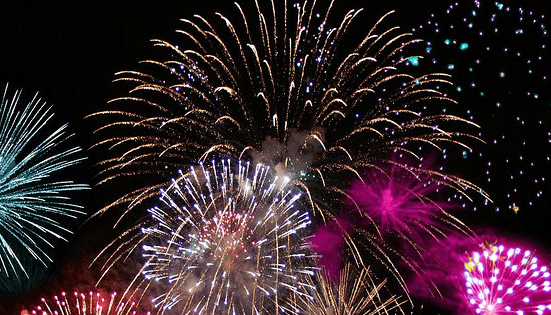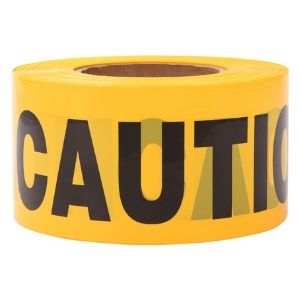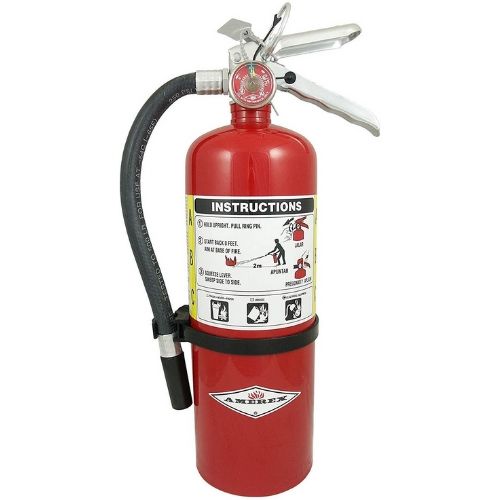The Chinese invented fireworks over a thousand years ago to frighten away evil spirits. But the only thing that should scare you today is using fireworks irresponsibly.
To keep fireworks fun and safe, check out our list of 13 tips to ensure that everyone stays out of harm’s way when playing with pyrotechnics.
Fireworks safety tips
- 1. Choose the right location
- 2. Designate a safety perimeter
- 3. Wait for appropriate weather conditions
- 4. Plan for accidental fires
- 5. Get moving after lighting the fuse
- 6. Pace yourself: light one firework at a time
- 7. Supervise your kids
- 8. Ditch faulty fireworks
- 9. Properly dispose of fireworks
- 10. Avoid illegal fireworks
- 11. Check your local laws
- 12. Sober is safer
- 13. Leave it to the professionals

1. Choose the right location
Only use fireworks in open, flat, inflammable, and sturdy spaces. Some of this advice might seem obvious, but the statistics suggest otherwise.
According to the National Fire Protection Association (NFPA), fireworks started an estimated 19,500 fires in 2018.1 If you’re going to set off legal fireworks, do it in a safe place.
How to choose a safe location for lighting fireworks:
- Scout out a location that’s hard and flat—like bare dirt, snow, concrete, sand, or stone.
- Avoid places with trees, grass, and buildings that could catch fire.
- Be considerate of noise pollution by setting off fireworks in a spot that won’t deafen neighbors and their pets.
Keep fireworks outside
2. Designate a safety perimeter
Use caution tape to create a lighting and launch zone away from spectators. Although consumer-grade fireworks are much smaller than the mortar shells used by professionals, they are still dangerous.
Phantom Fireworks, a popular fireworks manufacturer, recommends specific safety distances for ground- and air-based fireworks:2
- Ground-based: If you have a ground-based firework like a fountain, spectating from at least 35 feet away is best.
- Aerial: For aerial fireworks, you’ll want everyone to move back to a distance around 150 feet.
3. Wait for appropriate weather conditions
A windy day is a recipe for disaster when lighting fireworks. If it’s incredibly windy, postpone your fireworks show until the next day. Strong winds can push sparks out of your safety perimeter and into neighboring houses, buildings, trees, and grass, which can cause fires.
Gusts may also endanger you and your guests by sending sparks toward you or if fireworks tip over and launch in your direction.
Use your best judgment
4. Plan for accidental fires
Keep water (or a fire extinguisher) nearby. If something goes wrong, you’ll want a hose or bucket of water close by to extinguish the blaze.
For something more portable and robust than a water bucket, consider keeping a fire extinguisher near your fireworks area.
How much water will you need?
Firefighters use a formula to determine water ratios for putting out fires:3
| [(length x width of object on fire) ÷ 3] x percent of involvement = gallons per minute to put out a fire |
For example, if you have a 10’ x 15’ tool shed that ignites and 50% of it is on fire, you’ll need 25 gallons of water per minute (GPM) to put it out (garden hoses usually output up to 17 GPM).4 That might be shocking, but it demonstrates what you need to do to prepare for the worst and how quickly you should react to any fire.
5. Get moving after lighting the fuse
Light it, then get as far away as you can. Tragedies happen when people get too close to exploding fireworks. One of the more grizzly incidents happened in 2015 when a man died after using his head as a firework launch pad.5 Other accidental injuries involve burns, lacerations, and loss of limbs.
Over half of the estimated 10,000 firework-related injuries in 2019 were burns on faces, hands, arms, and legs.6 This means many people are too close for comfort when it comes to fireworks. Do yourself a favor and stay far away!
Safely lighting fireworks
- Move to a safe distance after the fuse ignites.
- Don't hold the fireworks you're lighting, including smoke bombs and firecrackers.
- Don't trim or shorten fuses to speed up the lighting process.
6. Pace yourself by lighting one firework at a time
More fireworks aren’t always better. Legal fuses must burn for at least three seconds,7 but that’s not a very long time on its own. If you’re lighting multiple fuses, you have an even smaller window to escape.
We mentioned that safe spectating distances for fireworks are anywhere from 35–150 feet, so you’ll need every second you can get.
Safer finales
7. Supervise your kids
Don’t underestimate something as small as a sparkler when it comes to your children. Sparklers caused 12% of reported injuries in 2019, making them more dangerous than firecrackers.6
Sparklers often burn at over 1,200 degrees Fahrenheit and can cause third-degree burns. To put that in perspective, glass melts at 900 degrees.
While they’re a fun staple for 4th of July picnics and other celebrations, make sure you’re around to supervise if your kids will be dancing around with these type of fireworks. Of course, keep them completely away from larger fireworks too.
Fireworks injuries in children
8. Ditch faulty fireworks
Duds always pose a risk. Sometimes fireworks don’t go off. The important thing to know here is that you should never try to relight or approach a failed firework.
Let duds sit for 5–10 minutes before you put them in a bucket of water. This can prevent injury from a delayed explosion and disarm the firework permanently so you can dispose of it.
9. Properly dispose of fireworks
Don’t throw used fireworks directly in the trash. After your fireworks or sparklers successfully go out in a blaze of glory, do not put them directly into the trash.
Instead, soak the charred remains in a bucket of water. This prevents used fireworks from igniting other garbage and creating a safety issue.
10. Avoid illegal fireworks
Don’t buy illegal fireworks. Legal fireworks reach store shelves after rigorous safety checks by the U.S. Consumer Product Safety Commission (CPSC).
The CPSC forbids fireworks that don’t meet stringent regulations:7
- Ground-based fireworks with more than 50 mg of powder
- Aerial fireworks with more than 130 mg of powder
- Fuses that burn for less than three seconds or longer than nine seconds
Only buy your fireworks from licensed dealers and choose models that are approved by the CPSC. Illegal fireworks don’t meet safety standards because they’re often too large for use.
Purchasing illegal fireworks can also land you with a ticket, jail time, or serious injury. And if you think the cops or neighbors won’t notice, it’s kind of hard to disguise a “boom” that big.
Fireworks labeling requirements
11. Check your local laws
Not every state allows fireworks. Some restrict use to simple things like sparklers and firecrackers. Crossing state lines to bring them back to your home is also illegal. You can only set off state-approved fireworks within that state’s boundaries.
If you’re not sure about your state’s firework laws, you can find them in the American Pyrotechnics Association’s state law directory.
Don’t forget to check with local authorities as well since many cities and counties have additional rules, including maps where firework use is forbidden.
12. Sober is safer
Don’t play with fireworks if you’re under the influence. Lighting an explosive when you don’t have your wits about you is dangerous. When you drink, you lose the ability to judge situations wisely. Your reaction time slows down and your coordination lessens.
Don’t put yourself in a position where you could endanger yourself or others. If you plan on drinking, don’t light off fireworks—simple as that.
13. Leave it to the professionals
If you can, attend a professional firework show instead of putting one on yourself. These shows use impressive pyrotechnics that you can’t buy in stores and are lightyears ahead of anything in your own show.
Professionals also know how to keep people safe and you won’t ever have to worry about sitting too close or getting a burn.
Final word
No matter what you decide to do, know the basics of firework safety. That way, nothing will get in the way of celebrating and you and your guests can remain safe. If you have your own tips about firework safety, please share with us in the comments section below.
For more information about fire safety inside your home, take a look at our review of the best smoke alarms.
Sources
- National Fire Protection Association, “Fireworks,” June 2007, Accessed July 1, 2020.
- Phantom Fireworks, “Safety Tips, Fireworks Safety,” May 2018, Accessed July 1, 2020.
- Firehouse, “Needed Fire Flow,” July 2010, Accessed July 1, 2020.
- S.F. Heron, Hunker, “How Much Water Goes Through a Garden Hose Per Minute?,” December 2017, Accessed July 1, 2020.
- Lindsey Bever, The Washington Post, “Maine Man Dies After Launching Fireworks from His Head,” July 2015, Accessed July 1, 2020.
- Consumer Product Safety Commission, “2019 Fireworks Annual Report,” June 2020, Accessed July 1, 2020.
- Consumer Product Safety Commission, “Consumer Fireworks Testing Manual,” August 2006, Accessed July 1, 2020.
- Consumer Product Safety Commission, “Fireworks Business Guidance,” January 2013, Accessed July 1, 2020.
Disclaimers
*Certain content that appears on this site comes from Amazon. This content is provided “as is” and is subject to change or removal at any time. Safewise.com utilizes paid Amazon links.
The post 13 Fireworks Safety Tips appeared first on SafeWise.
Aricle source here: 13 Fireworks Safety Tips


No comments:
Post a Comment